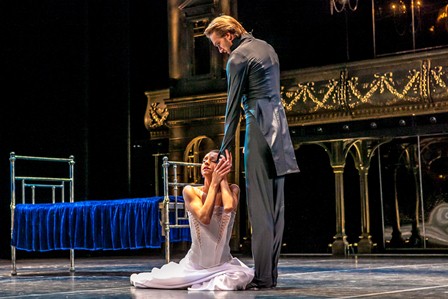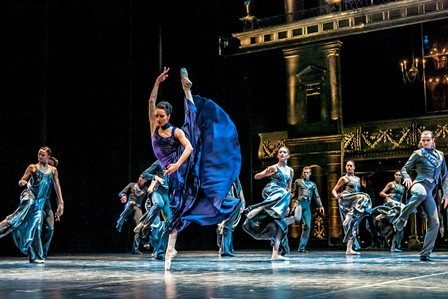15 August 2012, Capitol Theatre, Sydney
There is a lot to admire in Boris Eifman’s balletic interpretation of Leo Tolstoy’s novel, Anna Karenina. It is definitely not that Eifman covers all the complexities of the plot in his narrative but that, having chosen to reduce the storyline to a love triangle between the influential statesman Alexey Karenin (Oleg Markov); Anna (Nina Zmievets), his wife; and Alexey Vronsky (Oleg Gabyshev), cavalry officer and Anna’s lover; he presents a theatrically powerful distillation of the emotional heart of the novel.
Eifman emphasises individual incidents and single moments in the narrative and this approach is supported by a lighting design from Gleb Filshnitsky who uses strong spotlighting to direct the audience’s focus. I admired the quite minimal designs of the costumes by Slava Okunev with their reduced colour palette, largely of slate grey, black and white, and the multi-functioning black and gold setting by Zinovy Margolin with its architectural and historical allusions. They also supported Eifman’s vision. Alongside the three principals in this production, the corps de ballet becomes a kind of chorus filling roles as socialites, visitors to Venice, and eventually as the train that kills Anna.

Eifman’s choreography is an odd mixture of classical and contemporary movement. There is the temptation to think of Martha Graham, perhaps even Nacho Duato at times, and also musical comedy routines. But it is more a case of it being Eifman’s own brand of eccentric movement where bodies are twisted and contorted and thrown around dramatically. I am not particularly a fan of Eifman’s ‘flash-bang’ choreographic style, although the dancers clearly relished what they were dancing and that in itself is something to admire. For a while I didn’t notice that the women were on pointe, so focused was the choreography on flinging the body from one extraordinary shape and position to another. But once I started looking more closely I disliked the way the women used (or didn’t use) their feet. Pointe shoes look ghastly if the foot isn’t working strongly inside them and often it wasn’t, which totally destroyed the line of the leg in my opinion.

What I really didn’t like was the Tchaikovsky mash-up to which the work was set musically. In particular, there were some musical selections that are so closely identified with other ballets as to detract from what Eifman was trying to achieve. The scene in Venice where Anna and Vronsky have fled, for example, was danced to music that is used for that wonderful Polonaise in the finale of Balanchine’s Theme and Variations. No matter how elegant those black and gold Venetian carnival costumes were, it was all but impossible not to wish one was seeing Theme and Variations instead of Anna Karenina. Similarly, the ballet opened with the music that opens Balanchine’s Serenade, and again it is hard to not visualise that ballet rather than watch what is unfolding on stage in Anna Karenina.
I think it’s worth looking at Judith Flanders’ summation of Eifman Ballet as posted on theartsdesk.com not so long ago. She wrote, ‘Boris Eifman has always divided the critics. Western audiences tend to respond the way they do to car crashes: they are appalled, but find it hard to look away. Russians, meanwhile, virtually stand on their seats and scream for more.’ There is also an interesting comment posted at the end of the Flanders’ piece!
I wasn’t appalled, there was too much to think about and plenty to admire, but to my eyes Eifman’s way of presenting ballet is definitely eccentric. Having said that, perhaps we need a few more eccentricities here in Australia?
Michelle Potter, 17 August 2012